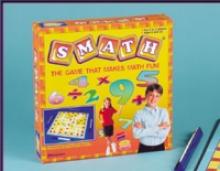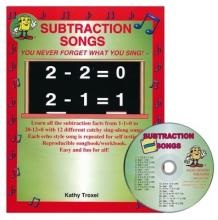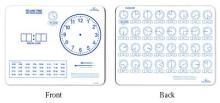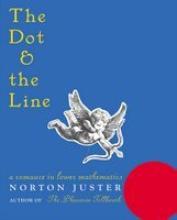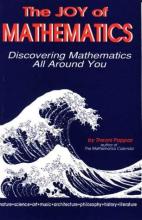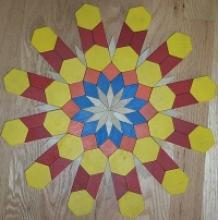Math
Smath: The Game that Makes Math Fun
Smath is a very similar game to Equate. It comes with a game board, 4 plastic tile racks and plastic tiles with a bag for the tiles. Tiles: 6 each of numbers 0-12, 10 blanks, 36 equal signs, 9 each of addition, subtraction, multiplication and division signs, and 12 clear parentheses that stack over another tile when used. There are no fractions or decimal points. Each player draws 10 tiles per turn. Game play is similar to Scrabble, but equals sign and parentheses tiles are kept separate and can be used as needed. This prevents game play from stalling.
Subtraction Songs
Audio Memory offers math audio tapes and CDs for practicing "Math Facts" in Addition, Subtraction and Multiplication. (Sold separately from each other). These are Math drills set to music (of the synthesized variety). Although these make for an easy memorization aid, I found the songs almost unbearably sappy. (My children did like them though.)
Telling Time Dry Erase Board
Nasco, 11" x 14" sturdy wooden dry-erase board
This is a sturdy and elegant little dry-erase white board for young children learning to tell time. Parents can use this for demonstrating principles of telling time or it can be enjoyed by young children for independent learning.
The front sports a large clock face complete with numbers but no hour or minute hands (these can be drawn in with a dry-erase marker). There is also a blank spot for a digital clock reading so that children can write in those numbers while practicing telling time. The bottom bar marks 32 different times that the child can practice.
The back has 32 small clocks marked with different times. The child can write the correct time underneath each clock.
What a great and reasonably priced product. We have two so that a younger sibling can participate too.
The Dot and the Line
"Freedom is not a license for chaos" is my son's signature below his email messages. It was written by Norton Juster, of The Phantom Toolbooth fame, and it comes from our almost-17-year-old's favorite book.
The phrase is the turning point and premise of this amazing, simply delightful little Math book. Math? That is our son's most disliked subject. Wait, The Dot and the Line is not a Math book! It is a hilarious comedy! But is that all? It is a romance, a story of love deeply felt, pursued, capable of provoking great things in the soul. In a little math book? Is it possible? Yes, it is.
Our classic languages-loving son reads it aloud every time this book visits us from the library. He suffers with the straight, dull and unbending line when driven to the "edge" (of the paper— the line is drawn on the edge of the page) as the "perfect by every measure" dot flirts around with the anarchist, slothful squiggle. Moved by great love, the line at first attempts to show its own grandeur by asserting its importance in art, world politics, sports. To no avail: the dot is not impressed. Then the unimaginable happens: when almost giving up, the line, using great concentration, becomes able to make angles!
What follows next is what makes this little book a great book: the enthusiastic line makes more and more angles in a chaotic frenzy, until... it realizes that chaos without order leads nowhere. It stops, straightens itself again and it discovers that freedom is not a license for chaos. From then on, life changes for the line: exercising great control and virtue, it discovers a new world:
For months he practiced in secret. Soon he was making squares and triangles, hexagons, parallelograms, rhomboids, polyhedrons, trapezoids, parallelepiped, decagons, tetragrams and an infinite number of other shapes so complex that he had to letter his sides and angles to keep his place. Before long he had learned to carefully control ellipses, circles and complex curves...
Ah, the virtue of Mathematics! The beauty of its exact angles and dimensions. The rhythm, art and music of what it is able to create, using exercise and order! I will refrain from spoiling it completely for the new reader, but let me repeat the "moral" of the story: to the vector, the spoils.
The back jacket, after telling us that the author, among other things, runs "a support group for negative numbers" (one can glimpse Mr. Juster's opinion of the state of the culture in the 60s) mentions an award winning film, and I found it on You Tube. I was happy to see that that the screenplay was also written by the author but I warn you that the book is much better. This new 2001 edition has wonderful graphics and some different pictures as well.
Original copyright 1963.
The Joy of Mathematics
This book is very good at what it does. However, you have to read the introduction to find out what it does. It is NOT a math textbook. And it is NOT a math program. You'd have to be a real geek to read it cover to cover. This is full of 1 (sometimes 2) page math things of all sorts. Little vignettes into the world of math. As such it introduces the reader to a number of things that he might not otherwise encounter. In fact, I am an engineer (lots'o'math) and I saw new and interesting things in here! Some of these are little games (answers in the back). Some are just fun to look at and ponder (many geometric things are this way). Some include little histories of a problem or mathematician.
What this book will probably do at some point is lead you to investigate some of these math ideas more deeply elsewhere. This is good! It sparks a good kind of excitement and wonder about math that everyone should be happy to experience now and then. Therefore, adult readers and capable children (decent readers but not necessarily good or enthusiastic about math) should both enjoy picking up this book a few times a week. For this reason this would be an excellent bathroom book.
Wooden Pattern Blocks
These beautiful wooden blocks are about 1/8th of an inch thick and come in six different shapes (each shape is a different color).They can be fitted together to make beautiful patterns and designs. We've been using them for many years and they've been a hit with every one of my children. They're fun and beautiful and promote fine-motor skills, eye-hand coordination (intricate patterns can be too frustrating to really young children) and visualization and thinking skills. One way I use them with my kindergarteners is this: the child and I will each start a pattern or design and then switch so that the other one has to finish it. The wooden set has such a nice feel to it - playing with it is so relaxing and peaceful for young children (especially while you're trying to work on academics with older siblings.
Available in various materials, sizes and quantities - we prefer the wooden set.
Also see:
The Mental Math Series by Kathy French
Related Websites:
Mrs. Glosser's Math Goodies is a free educational web site featuring interactive math lessons. "Our lessons use a problem-solving approach and actively engage students in the learning process. We also offer many other useful resources including Chat Boards, Puzzles, a Math Image Library, Educational Links, Calculators, and much more!"

